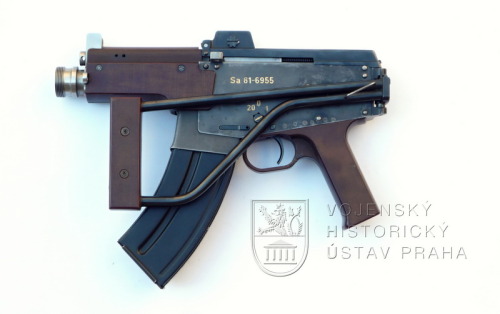historicalfirearms: Samopal 81 KrásaThe Sa 81 Krása (meaning ‘beauty’) was developed in the late
historicalfirearms: Samopal 81 Krása The Sa 81 Krása (meaning ‘beauty’) was developed in the late 1970s by Jiří Čermák, a Czechoslovakian Army engineer and designer. The Czechoslovakian Army requested that the Brno Research and Development Institute of the General Mechanical Engineering Works develop the weapon for use by troops who didn’t require a full-length rifle, including officers, artillery, logistics and armoured vehicle troops. The resulting weapon was based around the standard issue 7.62x39mm rifle round. It was just 31.5cm or 12.4in with its side-folding stock folded. This was 17cm or 7.1in shorter than the Soviet AKS-74u. Unloaded the weapon weighed in at 2.1kg or 4.6lbs, which in turn is 1.4lbs lighter than its Soviet counterpart. The Sa 81 fed from a 20-round magazine (the one pictured with the gun above appears to be proprietary) and had a hinged top cover, a side-folding wire stock and a short, fat flash-hider. It had a magazine well which protruded from the receiver, esquing the AK-pattern rifle’s rock to lock system. Interestingly the magazine well and release are reminiscent of those seen on the M16. It had a safety selector with positions for single, safe and fully automatic. While not ambidextrous the selector was marked on both sides of the receiver. The charging handle was positioned on the left side of the weapon with a folding, spring-loaded dust cover covering the ejection port. The prototype’s furniture appears to be wooden and of a blocky profile. The Sa 81′s interesting gas-piston and bolt assembly (source) Historically, Czechoslovakia was not afraid to forge an independent path from Soviet small arms doctrine having adopted the vz. 58 rather than the AKM. So the development of a local carbine was not surprising. The most interesting element of the SA 81 was its bolt. In order to keep the weapon short Čermák opted for a bolt which moved up and down. Rounds were pulled from the magazine and lifted up to the breech as the bolt moved forwards again. The Sa 81 was driven by a gas-piston with the breech locked by locking wedges. The weapon was ready for testing by the end of 1980 and was refined over two years with efforts to chamber it in the new Soviet 5.45x39mm round, as the Sa 83. By the mid-1980s, however, the project have been abandoned. Zbrojovka BRNO (ZB) donated a prototype, Sa 81-6955, to the Military History Institute in Prague in 1991. The Military History Institute (or Vojensky Historicky Ustav) has a short, but detailed, article which gives us the bulk of what we know about the weapon. Sources: Trial submachine gun Sa 81, Vojensky Historicky Ustav, (source) If you enjoy the content please consider supporting Historical Firearms through Patreon! -- source link
Tumblr Blog : www.historicalfirearms.info



